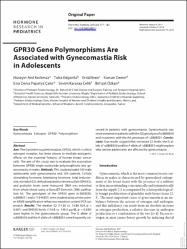GPR30 Gene Polymorphisms Are Associated with Gynecomastia Risk in Adolescents

Göster/
Tarih
2015Yazar
Korkmaz, Hüseyin AnılEdgünlü, Tuba
Eren, Erdal
Demir, Korcan
Çakır, Esra Deniz Papatya
Çelik, Sevim Karakaş
Özkan, Behzat
Üst veri
Tüm öğe kaydını gösterÖzet
Aim: The G protein-coupled receptor, GPR30, which is a third estrogen receptor, has been shown to mediate estrogenic effects on the essential features of human breast cancer cells. The aim of this study was to evaluate the association between GPR30 single nucleotide polymorphisms and gynecomastia in males. Methods: This study included 109 male adolescents with gynecomastia and 104 controls. Follicle stimulating hormone, luteinizing hormone, total testosterone, estradiol (E2), dehydroepiandrosterone sulfate (DHEAS), and prolactin levels were measured. DNA was extracted from whole blood using a GeneJET Genomic DNA purification kit. The genotypes of the GPR30 gene (rs3808350, rs3808351 and rs11544331) were studied using a tetra-primer ARMS (amplification refractory mutation system) PCR approach. Results: The median E2 (11.80 vs. 16.86 IU/l, p < 0.001) and DHEAS levels (116.8 vs. 146.5 mu g/dl, p = 0.044) were higher in the gynecomastia group. The G allele of rs3808350 and the A allele of rs3808351 were frequently observed in patients with gynecomastia. Gynecomastia was more common in patients with the GG genotype of rs3808350 and in patients with the AA genotype of rs3808351. Conclusions: Our results suggest that increased E2 levels, the G allele of rs3808350 and the A allele of rs3808351 might explain why certain adolescents are affected by gynecomastia. (C) 2014 S. Karger AG, Basel

















